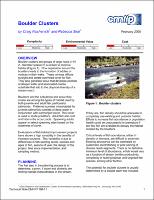Please use this identifier to cite or link to this item:
https://hdl.handle.net/11681/3990| Title: | Boulder clusters |
| Authors: | Fischenich, J. Craig, 1962- Seal, Rebecca |
| Keywords: | Boulders Ecosystem Management and Restoration Research Program (U.S.) |
| Publisher: | Engineer Research and Development Center (U.S.) |
| Series/Report no.: | Technical Note (Ecosystem Management and Restoration Research Program (U.S.)) ; no. ERDC/TN EMRRP-SR-11 |
| Abstract: | Boulder clusters are groups of large rocks (>10 in. diameter) placed in a stream to improve habitat (Figure 1). Flow separation around the boulders leads to the formation of eddies or vortices in their wake. These vortices diffuse sunlight and create overhead cover for fish. They also generate scour that develops pockets of deeper water and associated coarse substrate that add to the physical diversity of a stream reach. Boulders and the turbulence and scour they create are among the types of habitat used by both juvenile and adult fish, particularly salmonids. Preferred summer microhabitat for juvenile salmonids consists of deep water in conjunction with submerged cover. This cover is used to elude predators. Adult fish also rest and hide in the scour pools. Spawning adults appear to select spawning sites based on the closeness of cover. Evaluations of fish habitat improvement projects have shown a high variability in the benefits of instream boulders. This variability is due to differences in fish seeding levels, species and ages of fish, season of year, the design of the project, time since implementation, and sampling method. |
| Description: | Technical Note |
| Gov't Doc #: | ERDC/TN EMRRP-SR-11 |
| Rights: | Approved for public release; distribution is unlimited |
| URI: | http://hdl.handle.net/11681/3990 |
| Appears in Collections: | Technical Note |
Files in This Item:
| File | Description | Size | Format | |
|---|---|---|---|---|
| ERDC-TN-EMRRP-SR-11.pdf | ERDC/TN EMRRP-SR-11 | 643.41 kB | Adobe PDF |  View/Open |